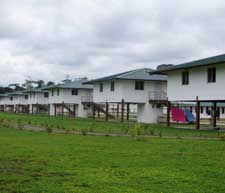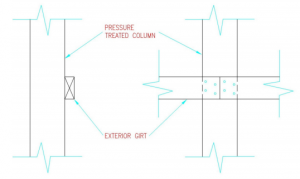Welcome to Ask the Pole Barn Guru – where you can ask questions about building topics, with answers posted on Mondays. With many questions to answer, please be patient to watch for yours to come up on a future Monday segment. If you want a quick answer, please be sure to answer with a “reply-able” email address.
Email all questions to: PoleBarnGuru@HansenPoleBuildings.com
DEAR POLE BARN GURU: Hi Mike,
Thank you for the fast reply. I am wondering what a column footing is, beyond the concrete 6” X 24” “post pad” which is supposed to be under that post . If we have to get to the bottom of the post, do you have any ideas how to do it without destroying that corner of the building? The building is finished inside and there is the concrete cap around the post. Of course that was poured before the floor.
The builder is brainstorming some idea about cutting the post off, pouring something to support it and bracketing the post to it. Have you ever heard/ done such a thing?
Thank you, BOB IN OREGON
DEAR BOB : A column footing would be the “post pad” beneath the column. It is possible the diameter of the footing is inadequate to transfer the imposed loads. This could be due to one or more of several factors: inadequately prepared site (soils not compacted during fill), soil having less bearing strength than the footing design (many companies use a default of 3000 psf for soil bearing pressure, we use only 2/3 unless requested otherwise), columns not tied to the concrete slab (in the event of one of the other issues being the actual problem, the hairpins may distribute some of the downward forces into the concrete floor), the load placed upon the footing may be greater than it was designed to carry. If the Engineer of Record (E.O.R.) was not adequately informed of what was potentially going to be added onto his building, then footings could be undersized.
Some extended reading about footing pads can be found here: https://www.hansenpolebuildings.com/2012/12/footing/
If indeed you need to get to the bottom of the column, it could be dug out from the outside – a good mini-excavator operator should be able to handle this task easily. If this is the choice, any fill replaced against the column must be adequately compacted in lifts.
Whoa – I believe most parties have the cart before the horse. You can do whatever you want to do and I will not be offended. You’ve asked for my opinion, so I will offer it here:
Hire a R.D.P. (Registered Design Professional – engineer or architect) to come out to your building site, do soils testing and design an engineered repair. The engineer is welcome to discuss possible solutions with me, it is a professional courtesy. Ideally this engineer will have been the E.O.R., as he or she will be the most familiar party and you will not have to pay extra to get someone less familiar with the structure up to speed.
It is possible to bracket a column, however it is a foolhardy endeavor without getting to the true root cause of the problem – one which takes a soil bearing pressure test (done by the engineer) in order to have a point to start from.
DEAR POLE BARN GURU: Lindal Cedar homes has a model called the Teton Chalet by chance do you have anything close in resemblance? SCOTT IN DAVENPORT
DEAR SCOTT: Hansen Pole Buildings has the ability to convert most any concept into a post frame building. The more information you can provide us with what you desire the finished building to look like, as well as dimensions, the closer we are going to be to your ideal dream home. Please keep in mind, in most cases, we do not design or provide interior non-structural walls. We’ve found these are the ones which clients typically start moving around, once the building shell has been completed.
DEAR POLE BARN GURU: On a 36×56 pole barn with living accommodations in upper level, we want to use scissor trusses. How far apart would they need to be spaced? Thanks KATHY IN BROADUS
DEAR KATHY: In order to provide other than a general answer, I would need to know the flat roof snow load, exterior and interior roof slopes desired, roofing and ceiling materials.
The most cost effective method is typically to place a double scissor truss in alignment with the sidewall columns, usually 12 feet on center. 2x purlins, on edge, would then be placed between the top and bottom chords of the trusses on joist hangers to support the roofing and ceiling material.









We are interested in building a pole barn home. I do not want a home built on a concrete slab can you build a pole barn barn with a regular Foundation.
Post frame (pole barn) homes can be constructed on a continuous foundation, however they will be far more affordable with columns embedded into the ground.